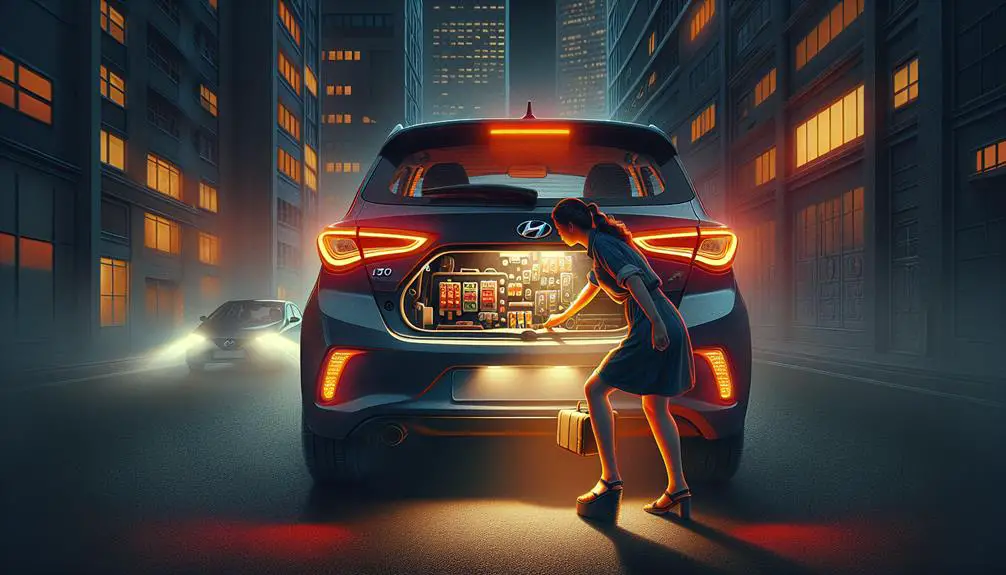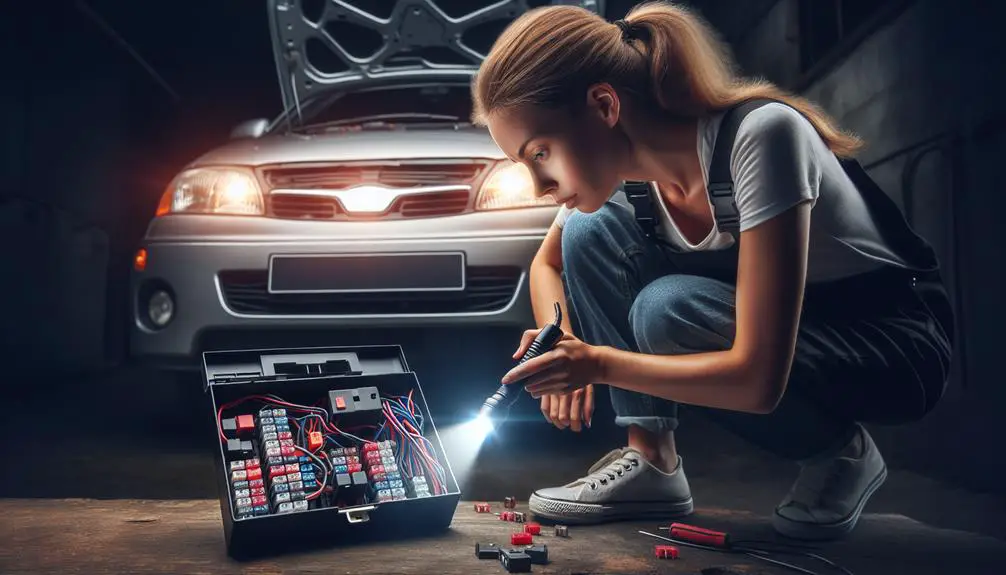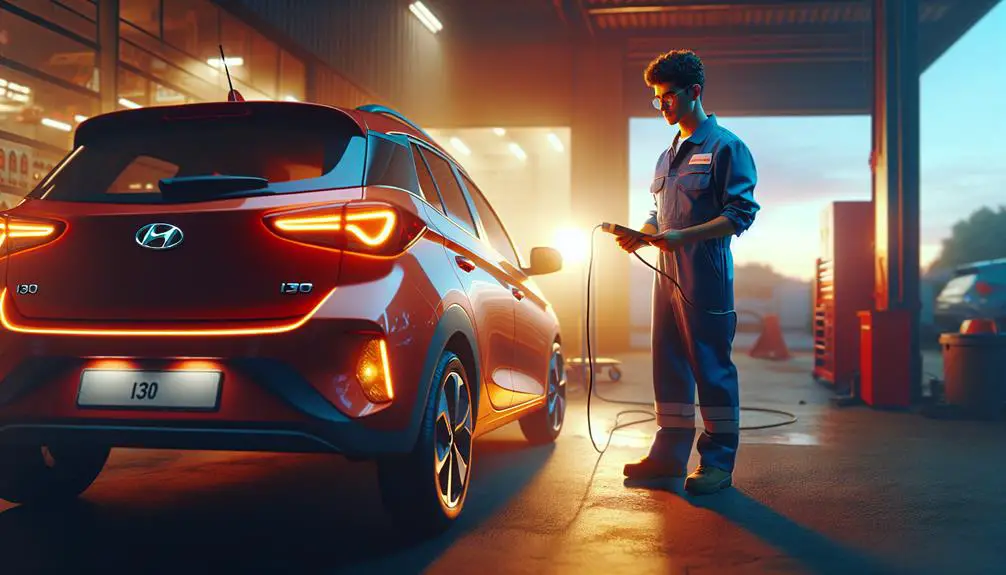The brake light switch is likely the cause of your Hyundai i30's brake lights staying on.
This issue, though seeming minor, is crucial to address quickly to prevent battery drainage or safety risks.
While troubleshooting involves examining various components, understanding the role each plays in the braking system is essential for a safe, functioning vehicle.
Understanding the Issue

Why are your Hyundai I30's brake lights staying on even when you're not pressing the pedal? You might find this peculiar, especially if it's your first encounter with such an issue. It's not just confusing; it could also potentially drain your car's battery and mislead other drivers on the road. There are a few reasons why this might be happening, and understanding them is the initial step to solving the problem.
First and foremost, it's important to know that your car's electrical system is intricate. A malfunction within this system can cause your brake lights to malfunction. For instance, a short circuit somewhere in the wiring could lead your brake lights to receive power continuously, regardless of whether you're pressing the brake pedal or not. This is less common, but it's a possibility.
Another reason could be related to the fuse that controls the brake light circuit. If this fuse is damaged or has malfunctioned, it might cause the brake lights to stay on. While fuses are designed to protect the electrical circuits by breaking the circuit when there's too much current, a faulty fuse can cause unpredictable issues like this.
You're also looking at potential issues with the brake light relay. This component is responsible for opening and closing the circuit that powers your brake lights. If it's stuck in the closed position, power will continuously flow to the brake lights, keeping them on.
Understanding these potential causes gives you a clearer direction on where to look and what to consider before moving on to more specific troubleshooting steps, like inspecting the brake light switch.
Inspecting the Brake Light Switch
One of the most common culprits behind your Hyundai I30's brake lights refusing to turn off is a faulty brake light switch. This little component, located near the top of the brake pedal, plays a critical role in controlling your brake lights. When it's not working correctly, your brake lights can stay illuminated, even when you're not pressing the pedal. Here's how to inspect the brake light switch effectively:
- Locate the Brake Light Switch: Initially, you'll need to find the brake light switch. It's usually mounted right where the brake pedal meets the car's interior. You might've to remove a panel or two to get a good look at it.
- Check for Physical Damage: Once you've identified the switch, examine it for any signs of physical damage. Look for cracks, fraying wires, or anything that seems out of place. If the switch is visibly damaged, it's likely the cause of your problem.
- Test the Switch: You can test the switch by pressing and releasing the brake pedal, checking to see if the switch moves accordingly. If it doesn't, or if it seems stuck, it's not functioning properly.
- Disconnect and Inspect: If you're comfortable doing so, disconnect the switch and inspect it more closely. Look for any corrosion or debris that might be interfering with its function. Sometimes, cleaning the switch can resolve the issue.
If you've gone through these steps and your brake lights still won't turn off, it's time to contemplate replacing the brake light switch or seeking professional help. Remember, dealing with electrical components can be tricky, so don't hesitate to consult a mechanic if you're unsure.
Checking the Fuse Box

After inspecting the brake light switch, the next step is to check the fuse box for any blown fuses that might be causing your Hyundai I30's brake lights to stay on. Locating the fuse box in your I30 is pretty straightforward; it's typically found under the dashboard on the driver's side or near the engine compartment. You'll want to consult your vehicle's manual to find the exact location and to identify the specific fuse associated with the brake lights.
Once you've located the fuse box, open it and inspect the diagram on the inside of the cover. This diagram will help you pinpoint the brake light fuse. It's usually clearly labeled. Now, you're ready to inspect the fuse itself. You're looking for any signs of damage or a broken filament. A blown fuse will often have a visible gap in the wire or a dark, smoky color.
If you find that the fuse is indeed blown, replacing it's your next step. Make sure you use a fuse with the exact same amperage rating as the one you're replacing. Using a fuse with a higher amperage could cause significant damage to your vehicle's electrical system. After replacing the fuse, test your brake lights again.
If the lights turn off as they should, you've solved the problem! However, if the brake lights still won't turn off, or if the new fuse blows shortly after replacement, there may be a deeper electrical issue at play. But remember, we're focusing on the fuse box right now, so make sure this step is thoroughly completed before moving on.
Exploring Electrical Problems
If your Hyundai I30's brake lights remain stubbornly on even after replacing a blown fuse, it's crucial to investigate potential electrical problems that might be at the root of the issue. Electrical faults can be tricky to diagnose, but having a few common culprits can guide you in the right direction.
- Brake Light Switch: This switch is what signals your brake lights to turn on when you press the pedal. If it's stuck or malfunctioning, your lights won't know when to turn off. You'll find this switch near the brake pedal. Check for any signs of damage or wear and consider replacing it if it seems faulty.
- Wiring Issues: Damaged or frayed wires leading to the brake lights can cause them to stay on. Inspect the wiring harness for any obvious signs of damage. Sometimes, the issue could be as simple as a loose connection that needs to be secured.
- Faulty Relay: A relay in your car's electrical system that's stuck in the 'on' position could keep powering the brake lights non-stop. Identifying and replacing a faulty relay can solve this problem.
- Bad Ground Connection: A poor ground connection can cause erratic electrical behavior, including brake lights that won't turn off. Check the ground connections to ensure they're clean, tight, and free from corrosion.
Tackling these electrical problems requires some knowledge and patience, but it's doable. Take your time to understand how each component works, and you'll be more equipped to diagnose and fix the issue, keeping your Hyundai I30's brake lights in proper working order.
Seeking Professional Help

Despite your best efforts, when the brake lights on your Hyundai I30 refuse to turn off, it's time to contemplate seeking help from a professional mechanic. You've tried the quick fixes—checking the brake light switch, ensuring there's no electrical short, and even looking into the fuse box. But sometimes, these measures just don't cut it. That's when you know it's time to hand the reins over to someone with the tools, skills, and experience to diagnose and fix the problem efficiently.
Here's a quick guide to help you visualize when and why you might need to seek professional help:
| Scenario | DIY Difficulty | Professional Help Needed? |
|---|---|---|
| Simple switch adjustment | Low | No |
| Electrical short finding | High | Yes |
| Complex wiring issues | Very High | Definitely |
Seeking professional help does not mean admitting defeat. It's about ensuring safety and functionality in your Hyundai I30. A professional mechanic can save you time and potentially a lot of money in the long run by preventing further damage to your vehicle's electrical system.
Conclusion
So, you've gone through the motions, inspecting the brake light switch, checking the fuse box, and delving into potential electrical issues.
If those brake lights on your Hyundai i30 still won't turn off, it's time to seek professional help. Don't wait around; a mechanic can quickly diagnose and fix the problem, ensuring your car's safety and compliance with the law.
Remember, tackling it early can save you from bigger headaches down the road.